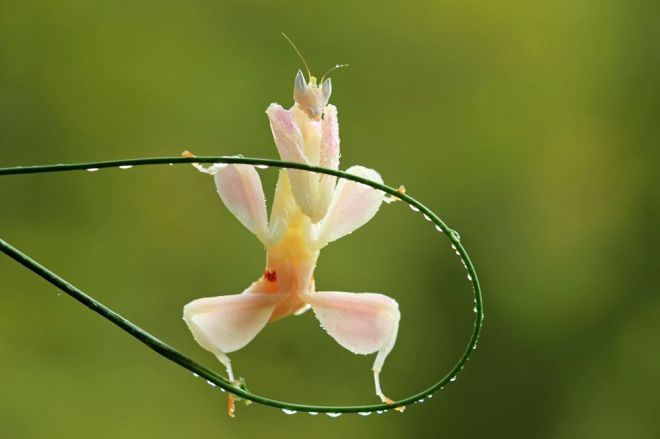
Hymenopus coronatus, more commonly known as the Orchid Mantis, takes on this elegant pink and white coloration with lobes on the legs that look like flower petals, thus claiming their name for the striking resemblance they have to flowering plants particularly within the Orchidaceae family. Orchid mantises fall into the order Dictyoptera, the suborder Mantodea, and the family Hymenopodidae. This insect is mainly found naturally in the tropical rain forests of Malaysia where it lives in bushes and small trees that typically grow pink and white flowers, but has also been discovered in other various areas of South-East Asia.
Mantises are usually known to have a generalist diet, however our friend the orchid mantis has been studied to have more of a specialist diet. Research that was posted in 2016 led by Dr. Gavin Svenson, Curator and Head of the Invertebrate Zoology program at The Cleveland Museum of Natural History (CMNH), has found that the female orchid mantis adult mimics flowers due to their ancestral affiliation with exploiting pollinator insects’ attraction to their natural food resources. Interestingly enough, this evolution does not even require the orchid mantis to sit among the flowers, but can attract the pollinator insects all on their own through this specialized evolution!

The article from CMNH describes the evolution of the female orchid mantis to cause a special case of sexual dimorphism, which is typically due to female egg production, however with the orchid mantis, size differentiation between the male and female mantis has been discovered to be for the females to lure the larger pollinators, such as bees or butterflies, while the males lineage occurred for a much different approach. Male orchid mantises kept their small, camouflaged appearance to hide from predators while still on the prowl for mates. For size reference, the female orchid mantis can reach a length of six centimeters with six abdominal segments while the male mantis can be found at a much smaller size, about two-and-a-half to three centimeters long with eight abdominal segments.
Orchid mantises undergo hemimetabolous metamorphosis, or “incomplete” metamorphosis rather, which also varies among females and males. Female orchid mantises must go through seven instars until reaching adulthood, with a life span of about eight months. Males go through five instars with a life span of five to six months only, leaving them with very little time to find a mate!

Cannibalism of the male partner via the female mantis is common in the Mantodea suborder, however this can be avoided if the partners, especially the female, have been well fed prior to the mating process. Upon fertilization, the female lays an egg-sack called an ootheca, which becomes firm and tough within about three to five days. Upon hatching, the first instar results in a dark orange body with black legs and a black head.

Once they have undergone their first molt, the orchid mantis nymphs become noticeably white with hot pink accents. Pink coloration will vary among individual specimens, but also throughout their lifetime.
The orchid mantis can be a rare find in their natural environment, so behavioral activities have not been studied heavily other than in captivity. Scientists have hypothesized the idea of the mantis mimicking the orchid flowers specifically, however it has not been clearly proven that this is the exact flower they are attempting to mimic.

In a study done by James C. O’Hanlon and his colleagues in 2014, they tested whether or not the orchid mantis camouflages among flowers or rather attracts the insects on their own. Their research team discovered that when the orchid mantis is placed alongside common flowering plants of their natural habitat, potential prey approached the mantises more often than the actual flowers, thus concluding that the mantises are attractive to the insects all their own by a phenomenon better known as aggressive mimicry!
References
Gilbert, J. (2015, January 27). Secrets of the orchid mantis revealed – it doesn’t mimic an orchid after all. Retrieved November 28, 2018, from http://theconversation.com/secrets-of-the-orchid-mantis-revealed-it-doesnt-mimic-an-orchid-after-all-36715
Malaysian Orchid Mantis. (n.d.). Retrieved November 28, 2018, from http://www.waza.org/en/zoo/choose-a-species/invertebrates/insects-and-millipedes/hymenopus-coronatus
O’Hanlon, J., Holwell, G., Herberstein, M., & Natural History Editor: Mark A. McPeek. (2014). Pollinator Deception in the Orchid Mantis. Retrieved November 27, 2018, from The American Naturalist, 183(1), 126-132. doi:10.1086/673858
New Research Challenges Traditional Views in Insect Evolution. (2016, December 1). Retrieved November 29, 2018, from https://www.cmnh.org/hymenopus
Svenson, G.J., Brannoch, S.K., Rodrigues, H.M., O’Hanlon, J., and F. Wieland. (2016). Selection for predation, not female fecundity, explains sexual size dimorphism in orchid mantises. Retrieved November 27, 2018, from Scientific Reports 6: 37753
O’Hanlon, J., Holwell, G., Herberstein, M., & Natural History Editor: Mark A. McPeek. (2014). Pollinator Deception in the Orchid Mantis. Retrieved November 27, 2018, from The American Naturalist, 183(1), 126-132. doi:10.1086/673858